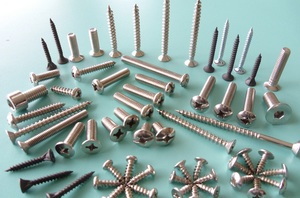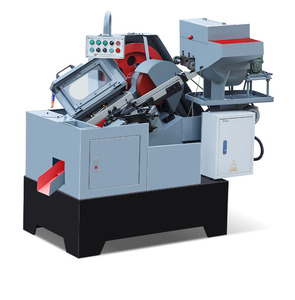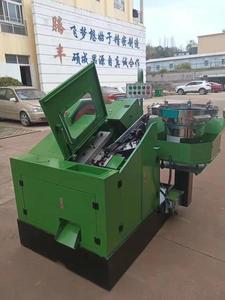
All categories
Featured selections
Trade Assurance
Buyer Central
Help Center
Get the app
Become a supplier

(890 products available)


























Scaffolding pipe thread rolling machines are made to roll threads on tubes and pipes that are used in scaffolding systems. Nonetheless, there are different types of this machine, as highlighted below.
Some key specifications of scaffolding thread rolling machines are as follows:
Like any equipment, scaffolding pipe rolling machines need maintenance. The main parts of the machine are lubricated regularly. This includes greasing driving shafts, bearings, rollers, and threads. Check oil levels on hydraulic parts and the pump. Conduct regular inspections to see if there is any wear or tear on the machine components. This will help find equipment issues early. Tighten loose parts and replace damaged ones. Clean the machine and remove any dirt or debris. If manual, set aside time for the threads machine to cool down before cleaning. If hydraulic or electric, use a dry cloth to wipe off oil or grease.
Thread rolling machines for scaffolding pipes are mainly used in the construction industry but have found their usefulness in other sectors due to their versatility and efficiency. Other industries that use these machines include the aerospace and automotive industries, which manufacture valves, axles, transmission shafts, and cylinder head bolts. The food and beverage industry also uses these machines to make pipes that transport various products.
Here are some applications of scaffolding thread rolling machines:
Determine the Thread Size Range:
When selecting a pipe thread rolling machine, it is crucial to assess the thread size range it can accommodate. Different industries and applications require varying pipe thread sizes. By evaluating the specific needs, ensures that the machine can handle the required thread sizes. This can avoid any compatibility issues and ensure smooth operations.
Consider the Maximum Pipe Diameter:
Considering the maximum pipe diameter the machine can handle is significant. Businesses and industries commonly work with pipes of varying diameters. By choosing a machine that can accommodate the required pipe diameters, the machine can efficiently roll threads onto pipes of any size. This can meet specific project requirements and eliminate the need for additional equipment.
Assess Material Compatibility:
It is essential to ensure that the pipe thread rolling machine is compatible with the materials. In various industries, pipes are made from different materials, such as stainless steel, carbon steel, aluminum, and more. Each material has distinct properties and requires specific handling. By choosing a machine compatible with the required materials, operators can maintain production efficiency and avoid damaging the pipes.
Think about Production Speed:
The machine's production speed plays a significant role in meeting project deadlines and production demands. Higher production speeds contribute to increased efficiency and productivity on the shop floor. This can streamline operations and reduce processing times. Opting for a machine with a faster production speed allows for more threads to be rolled in a given timeframe, ultimately improving overall output.
Evaluate Machine Accuracy:
Choosing a pipe thread rolling machine that offers high precision and accuracy is important to ensure consistent and reliable results. The machine's precise threading capability minimizes errors and variations, reducing the need for rework and enhancing the quality of finished products.
Q1: What are the rolling methods of thread rolling machines?
A1: There are three main types of thread rolling methods: cylindrical thread rolling, cone thread rolling, and taper thread rolling. Taper rolling involves using two conical rolls that rotate in opposite directions to shape the material into a tapered thread. Cone thread rolling is similar to taper rolling, as it uses conical or tapered rollers to form a cone-shaped threads. One of the rollers usually has a circular groove that matches the contour of the cone. Cone thread rolling is efficient for creating tapered threads on various materials. On the other hand, cylindrical thread rolling uses parallel cylindrical rollers to form threads on cylindrical objects. The process involves rotating the object between the rollers while applying axial pressure to the rollers. This method is commonly used to createPipeline andSkid Roller type threads.
Q2: What are the Applications of a Thread Rolling Machine?
A2: Thread rolling machines are used in various industries to mass-produce threaded components that are used in construction, joinery, and machinery assembly. In the construction industry, thread rolling machines are vital for producing components used in scaffolding systems. These components require specific thread profiles to allow secure connections between tubes and fittings. Thread rolling machines are used in the automotive industry to manufacture threaded parts such as bolts, nuts, and screws, which are essential for the assembly of vehicles. Other applications include creating pipeline joints in plumbing and oil industries. Thread rolling machines are also used to produce fastening devices like screws and bolts used in woodworking and electronics industries.
Q3: What are the advantages of thread rolling machines?
A3: One of the main advantages of a thread rolling machine is its ability to create materials with high-strength threads. This makes them ideal for use in industries that require high-load capacity. Another benefit is that thread rolling can produce threads faster than machining processes, resulting in higher production rates.
Q4: What materials can be used in a thread rolling machine?
A4: Materials like plastics and metals that can be deformed without breaking are compatible with the thread rolling machine. Low-carbon steel has a small percentage of carbon, which makes it very flexible, and this property enables it to go through the thread-rolling process. Alloy Steel is a steel made from a combination of several metals. It contains Chromium, Carbon, Manganese, Nickel, and other elements and can be used to make strong parts like Scaffolding threads. The high tool life of an item made from alloy steel is one of its main benefits. Stainless Steel is a steel alloy that contains 10.5% chromium and is highly resistant to corrosion. Stainless steel materials can be used in many applications, including construction, automotive, plumbing, and medical equipment, thanks to their durability and resistance to rust.